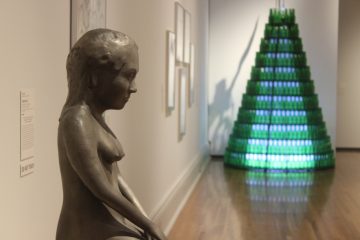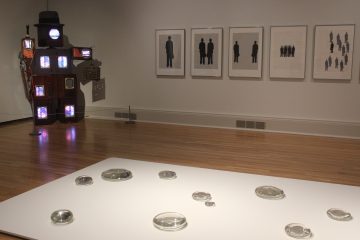By DAVID DUPONT
BG Independent News
The Toledo Museum of Arts has transformed storage space for light bulbs into a clean, well-lighted place for some of its most cutting edge art.
“Sights & Sounds: Art, Nature, and the Senses” is the inaugural exhibit in the New Media and Video Gallery. “Some of these works … we haven’t been able to show because we haven’t had enough space,” said Halona Norton-Westbrook, the museum’s director of collections who curated the exhibit.
Takashi Ishida’s “Walk of the Sea” is a prime example. Purchased in 2013, the three-screen high definition video has been in storage since. Now the museum has the space to do justice to its mesmerizing expanse.
“Sights & Sounds”, Norton-Westbrook said, explores human’s interaction with the world. That’s evident in another recently purchased work David Hockney’s “Woldgate Woods, Winter, 2010” that toys with the viewer’s concept of perspective with a grid of nine screens.
The black and white piece is a “personal meditation” on a place in England near where the British artist grew up, Norton-Westbrook said. It unfolds slowly over 49 minutes.

“Seated Nude” by Kiki Smith with Agus Suwage’s politically charged sculpture made of beer bottles in the background.
Hockney’s road provides a contrast to fellow British artist James Nares’ “Street.” While Hockney plays with perspective, Nares plays with time.
He filmed 16 hours of footage in his adopted home of New York City out of the back of an SUV. He then edited down to 61 minutes video that has been radically slowed down – if shown at natural speed, it’d last only three minutes.
In speaking to staff, Museum Director Brian Kennedy noted that “Street’ shows the link between anthropology and art.
“Street” captures people going about their day-to-day routines, living out the stories of their lives that are only hinted at in their brief appearances on film. Still they pique interest. What is up with the youngster shown running down the street with a smile on his face?
The exhibit features an international cast of artists.
Iranian artist Monir Shahroudy Farmanfarmaian is represented by “Aram (Convertible Series).” The cut-glass mirrored construction reflects the influence of American artist Frank Stella.
Norton-Westbrook noted the floral images and patterns in the work. Two works on paper by Farmanfarmaian are on the walls nearby. One focused on flowers, the other on the geometric shapes used on “Aram.”
The piece is also notable in that the pieces of the work can be arranged in 12 different patterns. Norton-Westbrook said that, though the rearrangement is involved the museum, plans to show the work in another form at some point.
Judit Reigl, a Hungarian artist living in France, draws her inspiration from music. “Art of the Fugue” captures her experience of listening to the music of J.S. Bach. The blocks of abstract shapes created with enamel, acrylic paint, and powered bronze look like they could be a form of musical notation.

Maya Lin’s “Dew Point 18” with Nam June Paik’s “Beuys Voice” in the background.
Ohio-born Maya Lin, who designed the Vietnam Veterans Memorial, is represented by two water-themed pieces, “Dew-Point,” glass spheres stretched across the floor and a silvery representation of Lake Erie that evokes its beauty and fragility.
The exhibit also includes several works familiar to museum visitors. That includes Nam June Paik’s multimedia sculpture “Beuys Voice.” The three-dimensional portrait has been a fixture in the contemporary art gallery right off the Libbey Court. Now in this new space it can be seen from a fresh perspective with its outline of a human form clearly delineated.
And while much of the attention in the show is on new media, traditional media are well represented. Chinese artist Zeng Xiaojun’s ink drawing “Qing Qi Gu Guai (Clear, Wondrous, Ancient, Strange)” is a finely wrought piece depicting a well-weathered, twisted trees in the mountains. The colored drawing is 11-feet long and took the artist three years to complete. The drawing, which continues the ancient tradition of Chinese art, benefits as much as the new media from the new gallery.
The gallery offers not just space, but is also wired for all the technology contemporary artists may draw on, said Stephanie Elton, the museum director of communications.
Though it has been used most recently for storage, Norton-Westbrook said, when this wing of the museum was added in 1933 the area was “roughed out in the plans” as a gallery.
About half of the area was used to store light bulbs. When the museum switched to LED lighting “we didn’t need all those light bulbs,” she said.
That allowed the museum to reimage and repurpose the space, Norton-Westbrook said. Now that space is a gallery that puts contemporary art in a new light.
“Sights & Sounds: Art, Nature, and the Senses” continues through Feb. 24.





